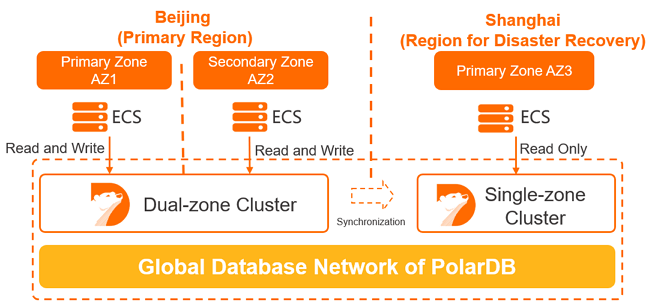Geo-disaster recovery and cross-region deployment are typical scenarios in which global database networks (GDNs) are used. This topic describes the service architectures of these two scenarios and shows how to deploy GDNs in these scenarios.
Geo-disaster recovery
The geo-disaster recovery feature allows you to achieve high availability across regions. This enhances data security and improves service availability. If a data center fails, services can be rapidly recovered. Architectures can be implemented, such as three data centers across two zones, four data centers across two zones, and six data centers across three zones.
Typical industries include banking, securities, insurance, and fintech.
The following figure shows the service architecture of three data centers across two zones.
A GDN consists of two PolarDB clusters. The following figure shows an example of a GDN.

The cluster in the China (Beijing) region is deployed in two zones: AZ 1 and AZ 2.
The cluster in the China (Shanghai) region is deployed in a single zone.
The application is deployed in the China (Beijing) region and performs local read and write operations on the database in AZ 1.
If AZ 1 in the China (Beijing) region fails, the service is preferentially switched to AZ 2 in the China (Beijing) region.
If AZ 1 and AZ 2 in the China (Beijing) region fail, the service is switched to AZ 3 in the China (Shanghai) region.
Cross-region deployment (active geo-redundancy)
The services of an enterprise may be deployed across countries or on a global scale. In this case, data must be synchronized to enable cross-region reads and writes. GDN ensures that the database can be accessed from multiple regions across the globe. In most cases, read requests are forwarded to the secondary cluster in the same region, while write requests are forwarded to the primary cluster.
Applicable industries: gaming, cross-border e-commerce, local services (food delivery), and new retail (outlets).
The following figure shows the service architecture of the cross-region deployment:
Each application deployed in a region can read data in the database that is geographically the nearest. When an application writes data to the database, the request is forwarded to the primary cluster. This can optimize the performance of data reads and writes.
Each cluster in a GDN, including the primary cluster and secondary clusters, has an individual cluster endpoint. You can use the endpoint of the cluster that is deployed in the nearest region to your application to connect to the GDN. GDN also provides a unified endpoint for all clusters. It allows you to access the nearest cluster in the GDN and keep the global domain name unchanged after a primary cluster switchover is performed in the GDN.
The cluster specifications can vary across regions. For example, the cluster specifications in the China (Shanghai) and China (Shenzhen) regions do not need to be the same as the specifications in the China (Beijing) region. You can select the specifications based on your requirements.

Procedure
Create a GDN and select an existing cluster as the primary cluster of the GDN. For more information, see Create a GDN.
Add a secondary cluster to the GDN. For more information, see Add a secondary cluster.
Connect to the GDN. For more information, see Connect to a GDN.
For information about the best practices for deploying a GDN across regions, see Best practices for deploying a GDN.